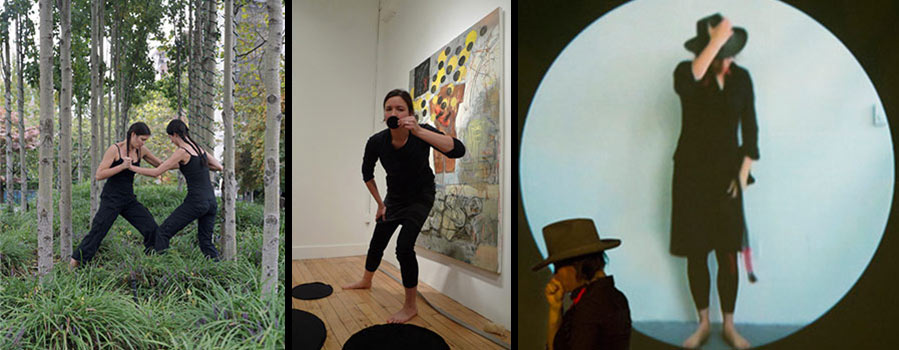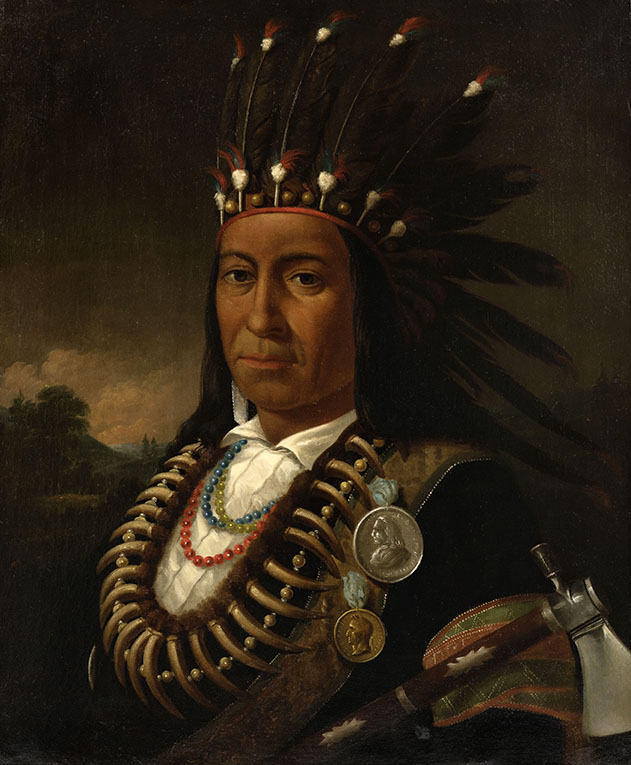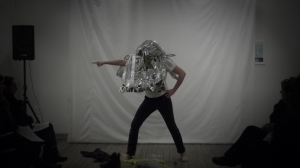
Maria Hupfield
Maria Hupfield is an artist working in a variety of media and currently based in Brooklyn. Her work has been shown at the Museum of Arts and Design New York, Toronto Power Plant, 7a*11d International Performance Festival, the National Gallery of Canada, and the Smithsonian’s National Museum of the American Indian, among other venues. For more on Maria visit mariahupfield.wordpress.com.
Tell us about yourself…
I am an artist living in Brooklyn, New York and a member of Wasauksing First Nation, from Ontario, Canada. I hand sew objects, worn on the body, using industrial felt and also shiny reflective materials. I then activate the items in various arrangements, performances, and 2D references.
American Indians are sometimes portrayed as sorrowful, non-threatening, or pitiable, and doomed to extinction. How do we defy these stereotypes?
The survival of present day Native Americans and our growing birth rate is contrary to this belief and is evidence showing strength of spirit in the face of great atrocities. The treatment of Native Americans reflects a society that is sorrowful, threatening to its citizens, and pitiful on its way to extinction, taking with it clean air, water, and land.
The reality of day-to-day living for urban Native people defies these stereotypes. Keeping up with the outfits worn in competition Pow Wows is the most obvious example I can think of that shows a thriving current culture that is alive and constantly absorbing elements from its surroundings.

What do you want people to know about Native American cultures?
Not everything is for sale and most things you will never understand, but you can stand with Native Americans so long as you don’t use your privilege to speak for us or silence us by making it about your tears.
What are your thoughts on the value of Native artists representing their own cultures?
 Context is everything. It isn’t a given that everyone can speak for their nation, but they can speak to their own experience.
Context is everything. It isn’t a given that everyone can speak for their nation, but they can speak to their own experience.
It always depends on the artist and who the art is for, as well as what their beliefs are, and their relationship with or accountability to living Native people.
How can we address the inaccurate images in our collection?
Add relevant labels and don’t speak as an authority about Native cultures that are not your own. Let Native people speak to their own individual experience in their own words. Have Native people on your board and at meetings. Create spaces for living Native people to participate in the life of the museum through residencies, panels, art exhibitions, as guest speakers, workshop leaders, language speakers, and in as many ways as possible.
Video of Maria Hupfield
Created for Nordamerika Native Museum’s (Zurich, Switzerland) Native Art Now exhibition of contemporary indigenous art.
Image credits (left to right; top to bottom): Maria Hupfield (born 1975), Counterpoint Three, Series of Six, 2007. Chromogenic photograph, 30 í— 40 inches. Courtesy of the artist. Maria Hupfield (born 1975), All is Moving, 2013. Performance at Accola Griefen Gallery. Image courtesy of the artist. Painting behind Maria: Jaune Quick-To-See Smith, Shock and Awe, 2011. Oil on canvas, 72 í— 48 inches. Image of Maria Hupfield (born 1975) Courtesy of the artist. Paul Kane (Irish-Canadian, 1810-1871), Portrait of Maungwudaus, circa 1851. Oil on canvas, 30 í— 25 inches. Tacoma Art Museum, Haub Family Collection, Gift of Erivan and Helga Haub. Video of Maria Hupfield by Dylan McLaughlin hosted on Vimeo.